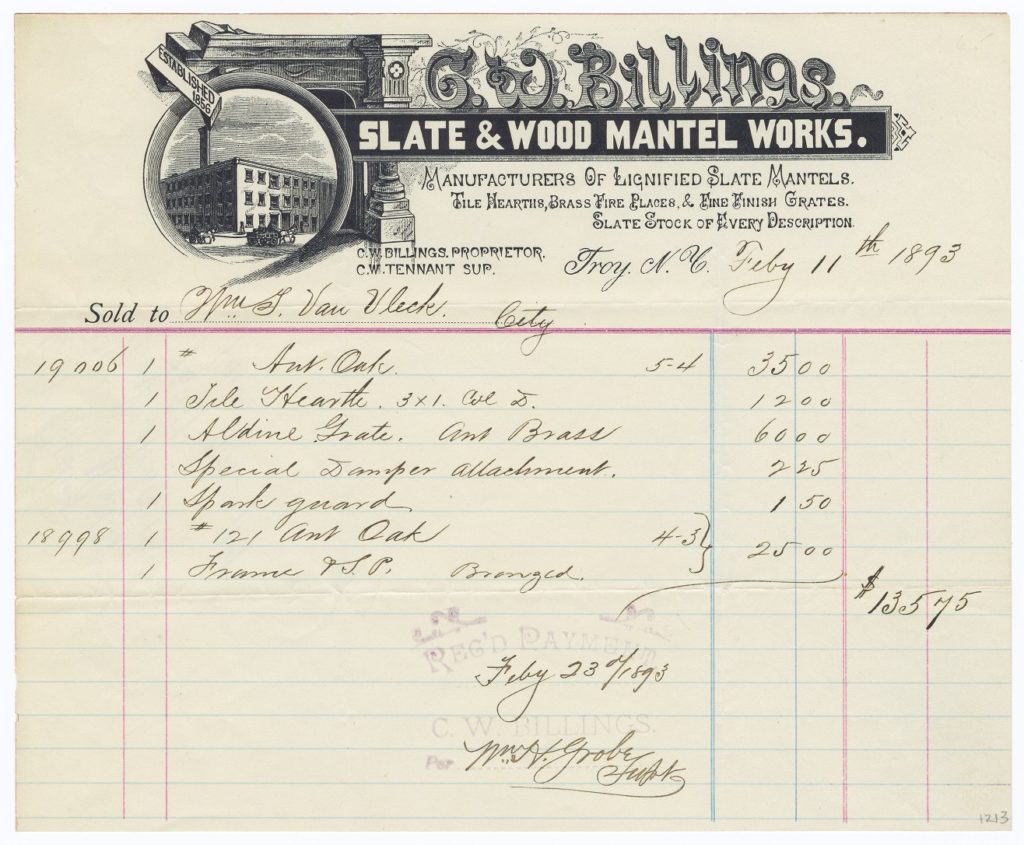
Another magnificent billhead from the Biggert Collection. C.W. Billings was the proprietor of a factory that made slate and wood mantels, as well as tile hearths, brass fire plates, and fine finish grates. In the age before central heating, when every home had a fireplace and the well-to-do might have several, being in the mantel business was not a bad gig. And being that marble was expensive, being able to fake it with slate was an even better gig.
Billings operated at North Third (now gone) and Hutton Streets, somewhere just south of where the Collar City Bridge and Route 7 connect to Hoosick Street today. In 1893, you (presuming you were William Van Vleck) could procure an antique oak mantel, a tile hearth, an aldine grate of antiqued brass, a special damper attachment, a spark guard, a second mantel and a bronzed frame all for the low, low price of $135.75. (The average wage for a worker in New York in 1893 was $460.41.)
Arthur Weise, who in his “The City of Troy and Its Vicinity” was, we must admit, given to gushing, gushed over C.W. Billings:
C. W. Billings, manufacturer of marbleized slate mantels, southeast corner of North Third and Hutton streets. The art of counterfeiting the handiwork of Nature has been attained to such perfection as to cause no little astonishment to those who for the first time inspect the excellent imitations made by man. By mechanical and chemical processes a marbleized slate is made at the manufactory of Charles W. Billings which seems not only to possess the varied tracery of veined marble and all the effects of the natural stone, but, singular, as it is true, it preserves its lustre longer and is not discolorable as the latter. The slate is obtained from quarries in Vermont, and is subjected at the works in Troy to the tools of the pattern designer and afterward to the processes of undertoning and marbling, and finally to the action of heat. The marbles of Spain, of Egypt, and of this country are so faithfully imitated that it is difficult to detect the dissimilarity existing between the real and the manufactured specimens. The imitations of rosewood, walnut, and other ornamental wood also manufactured at the establishment, are very attractive and beautiful. The mantels constructed with them and the marbleized slate are very elaborate and artistic. Mounted in brass or other metallic frames, with fenders of the same metal, they ornament a parlor, sitting-room, or library in a handsome manner. Besides manufacturing marbleized slate and wood mantels, C. W. Billings also employs his skilled workmen in making marbleized bureau, wash-stand, and table slabs, hearth tiles and facings, floor-tiles, improved grates, and many other useful and decorative specialities.
The manufactory is a large, three-story, brick building, fronting seventy-eight feet on North Third Street and extending one hundred and thirty to North Fourth Street. The business was begun, in 1860, by Edwin A. Billings, the father of the present proprietor of the works, at No. 421 River Street. In 1861, he moved to the building on the southeast corner of North Third and Hutton streets, previously the Pond Brothers’ foundry. In 1866, his son, C. W. Billings, succeeded to the business, who afterward renovated and enlarged the building to meet the demands of the rapidly increased patronage which his enterprise and productions had obtained.
I wonder how many of the grand homes of Troy still have a Billings slate mantel, looking just like fine marble?

Leave a Reply